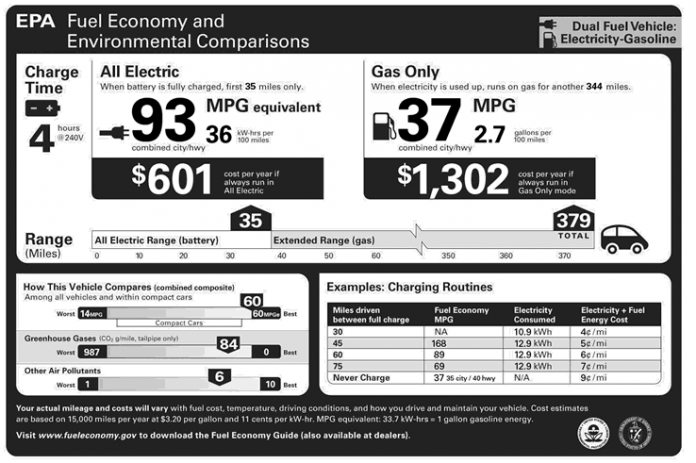In April, the National Highway Traffic Safety Administration (NHTSA) announced the new Corporate Average Fuel Economy (CAFE) standards that automobile manufacturers must adhere to through 2026. Unfortunately, the new rule is likely to lead to a shortage of new gasoline-powered cars in the coming years while massively hiking the price of battery-powered electric vehicles (EV) as well as cars powered by internal combustion engines (ICE).
In 1975, CAFE standards were created by the Energy Policy Conservation Act in response to the oil embargo imposed by the Organization of Arab Petroleum Exporting Countries in 1973. CAFE imposes fines on car and truck manufacturers if they fail to achieve minimum targets for sales-weighted average fuel economy, which is expressed in miles per gallon (mpg).
NHTSA’s new rule requires a massive 40 percent increase in mpg from now to 2026. Fuel efficiency must rise 8 percent in 2024 and 2025 model year automobiles, and 10 percent in 2026 model year automobiles, to a 49-mpg car and truck fleet average. Historically, the most manufacturers have been able to increase mpg year-over-year is about 3 percent. So, surging average mpg by a whopping 10 percent is a tall order.
Adding insult to injury, the Environmental Protection Agency (EPA) has separately set carbon dioxide (CO2) emission limits on automobile fleets. By 2026, cars will have to produce an average of 132 grams of CO2 per mile (g/mile) and light trucks an average of 187 g/mile for a fleet average of 161 g/mile, a 28 percent decrease from 2022. If vehicles do not meet this standard, EPA will not certify them for sale.
The challenge with this ruling is no cars with an internal combustion engine, that is, every automobile that runs on gasoline, currently emit CO2 at this extremely low level. The lowest-emitting car is the 2022 Toyota Prius Eco at 159 g/mile. Trucks like the Ford F-150, Dodge Ram, and the Chevrolet Silverado, the three most popular automobiles in the country in terms of sales, emit 407 to 550 g/mile, depending on engine size.
Meeting these new NHTSA and EPA standards so quickly will require manufacturers to dramatically increase expenditures on research and development, which will increase the price of new ICE-powered vehicles and force manufacturers to build an extensive portfolio of EV models.
Another factor that will exacerbate this shortage is the waiver provided to California to make the Golden State exempt from Section 209 of the Clean Air Act, which prohibits any state from adopting emissions standards more stringent than the federal standard. California’s Advanced Clean Cars Program requires that 35 percent of car sales in the state must be EV sales by 2026, rising to 50 percent of all sales in 2030. What’s more, 16 states and the District of Columbia have opted in to California’s program.
NHTSA, EPA, and California are essentially pushing manufacturers to eliminate ICE-vehicle production in favor of EVs. Naturally, this will accelerate the demand for commodities required to manufacture car batteries, which will increase the cost of EVs. Ford recently announced that due to rising material costs, the Mach E EV costs $25,000 more to manufacture than the equivalent sized gasoline-powered Edge. Nationally, the average price of EVs is currently more than $15,000 higher than the cost of gasoline-powered vehicles, and the gap is widening.
Moreover, we are likely looking at a shortage of ICE-powered vehicles, as there will be few models that meet the new emissions requirements. Vehicle affordability will be made worse with rising interest rates. With a smaller volume of sales, manufacturers will be forced to increase prices on both EVs and gasoline-powered vehicles. Customers priced out of the market will keep their older, less-safe vehicles that have higher emissions and consume more fuel. Of course, the lack of new vehicles will likely intensify the shortage of used vehicles, which has led to soaring prices for used vehicles in recent months.
The law of unintended consequences almost always follows even the best-intentioned law or regulation, and that will certainly be the case here. Few people have any concept of what the total impact of these regulations will be, though we will all certainly find out soon. My advice is simple: prepare to pay a whole lot more for a new car in the coming years, if you’re able to find one.
Tim Benson (tbenson@heartland.org) is the senior policy analyst at The Heartland Institute, a national free-market think tank headquartered in Arlington Heights, Illinois.
Originally published by Human Events, republished with permission.
For more on CAFE standards, click here.
For more on automobile emission standards, click here.


























